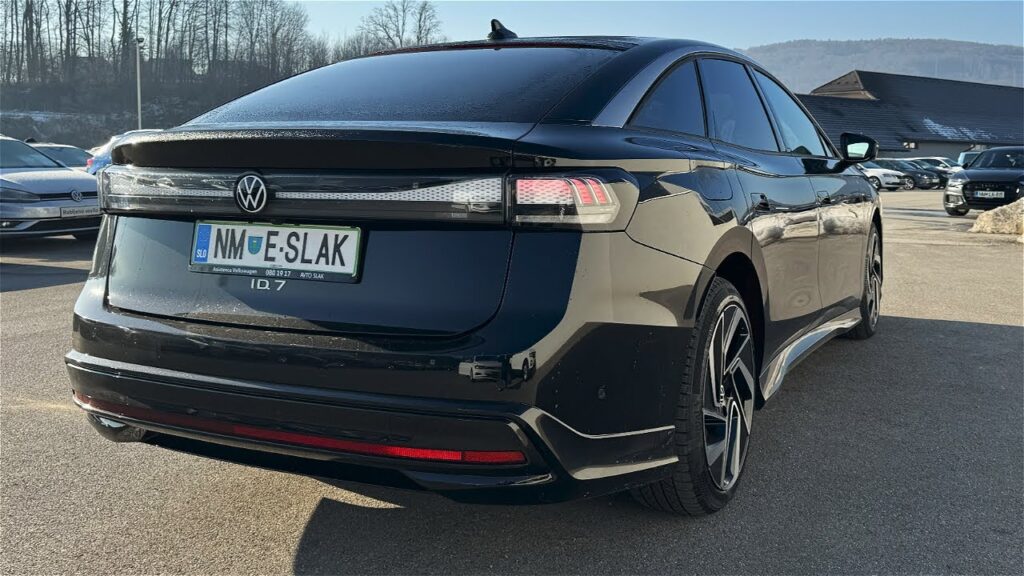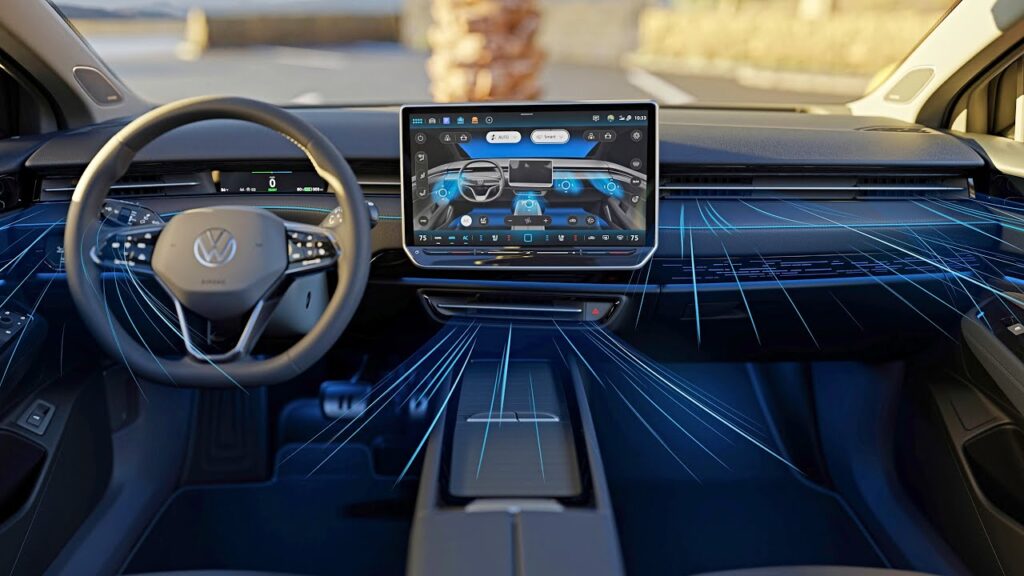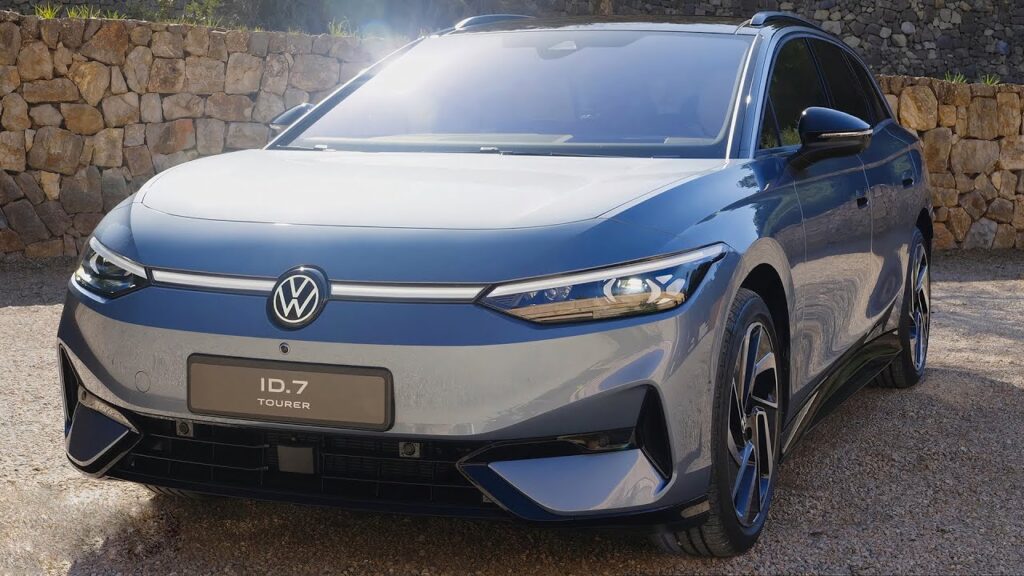Film reboots, from Top Gun: Maverick to Wonka, can earn a lot of money, and with the Volkswagen ID 7, the company hopes the same is true for electric vehicles. That’s because the all-electric ID 7 has become the brand’s flagship executive vehicle, serving as a reinvention of the VW Passat.
Those are huge shoes to fill, and VW takes the executive vehicle class seriously, so the ID 7 has plenty of tech and a large cabin to help it compete. Furthermore, one version’s stated range is long enough that you could theoretically drive it from London to Edinburgh without stopping to charge (real-world ranges vary).
Comprehensive Review of the Volkswagen ID 7: Range, Performance, and Comfort Compared to Tesla Model 3 and Mercedes EQE
| Aspect | Details |
|---|---|
| Strengths | Enhanced at every pace |
| Long range | |
| Comfortable ride | |
| Cons | Rivals are more agile to drive |
The entry-level VW ID 7, known as the ID 7 Pro, has an official range of 384 miles, which is comparable to the Tesla Model 3 Long Range (390 miles). Meanwhile, the ID 7 Pro S can officially travel 436 miles on a full charge, theoretically outlasting the much more costly Mercedes EQE 350 (429 miles).
Because the ID 7 GTX has an additional motor to drive, the range is somewhat reduced if you choose the four-wheel drive option. Officially, that can cover 365 miles.
It seems obvious that the ID 7 is intended to be a sophisticated long-distance cruiser given those astounding numbers. It’s also polished. When you get to highway speeds, there is almost no motor whining, and compared to a BMW i4 or Tesla Model 3, there is less road and wind noise at 70 mph.
We enjoy the adaptive regenerative braking on the ID 7, even though the brakes aren’t the most advanced. If the automobile ahead slows down, it automatically applies the brakes, gradually and gently, while simultaneously charging the battery.
Although the ID 7 lacks the Model 3’s one-pedal driving capability, which allows you to stop and start in town with little to no brake pedal pressure, the system is excellent on highways.
The ride quality of the ID 7 Pro and Pro S Match’s basic passive suspension is similar to that of a BYD Seal, meaning it is generally soft but occasionally trips over jagged abrasions.
Because of this, we advise installing the Dynamic Chassis Control (DCC) adaptive suspension system, which comes standard on the ID 7 GTX and is an option in the Exterior Pack Plus package for the Pro and Pro S models. It performs a far better job of smoothing out rough roads to provide a degree of comfort on par with the considerably more costly Mercedes EQE.
The ID 7 GTX features a little stronger setup than the Pro and Pro S models, and it also incorporates standard-fit DCC. Although it does shake passengers more in their seats over larger bumps, it still maintains the majority of ride comfort, especially when using the optional 21-inch wheels (for optimal comfort, stay with the basic 20-inch ones).
In terms of dynamics, the ID 7 steers precisely and grips firmly enough to feel somewhat nimble, but if you exert more force, you’ll discover its limitations sooner than you would with a Tesla Model 3 or BMW i4. Although it is standard on the GTX and an option on other models, the Progressive Steering technology, which accelerates the steering reaction at low speeds, does little to improve the experience.
The ID 7 wasn’t really designed for speeding down a rural road, but in its harder settings, the DCC suspension performs a respectable job of minimizing body lean during rapid direction changes. The GTX isn’t very thrilling to drive, but it leans less while turning quickly.
What about the performance? Entry-level ID 7 Pro models can reportedly go from 0 to 62 miles per hour in 6.5 seconds and use a single 282 horsepower electric motor powering the back wheels. With its larger battery, the Pro S takes 6.6 seconds, while the GTX’s two motors provide 335 horsepower, which reduces the time to 5.4 seconds.
Squeezing the accelerator pedal causes the ID 7 to accelerate without hesitation, regardless of the version you choose. Indeed, it’s easy to overtake slow-moving traffic and drive away from intersections.

Comprehensive Review of the Volkswagen ID 7: Interior Comfort, Advanced Features, and Driving Experience
Getting comfortable behind the wheel of the VW ID 7 is really simple. Its driving stance, which aligns you with the steering wheel and pedals, is essentially sound. The base chairs come with a memory function, massaging feature, and lots of motorized adjustability and lumbar support.
The ID 7 is a relatively simple automobile to look out of, even though its sweeping profile would often compromise visibility. While the large back windows and cutouts in the broad rear pillars provide you a wonderful view over your shoulder, the narrow front window pillars do make it simple to look out at intersections.
Even better, the ID 7 comes with a 360-degree view camera and front and rear parking sensors to make parking this five-meter-long luxury automobile easier. VW’s Park Assist Plus technology, which enables the vehicle to park itself in specific spots, is also installed. Driving at night is also made easy with standard-fit matrix LED lights, which you may leave on high beam without blinding oncoming traffic.
The majority of the information is shown on the head-up display, which allows you to view it without taking your eyes off the road, but the digital driver’s display is somewhat thin and uncustomizable.
The cabin of the ID 7 is far superior to that of any other VW electric vehicle. Soft-touch plastic on the dashboard, suede inserts on the doors, and perforated vegan leather on the seats are just a few of the aesthetically pleasant elements used.
Along with the 15-inch infotainment screen that takes up much of the inside, the glossy black trim and the touch-sensitive climate control sliders are illuminated, adding some much-needed visual glitz.
That is also a huge advancement. Compared to earlier ID vehicles, the touchscreen responds more quickly, and its enormous size lets you view a lot of information at once. Compared to earlier VW systems, there are a lot less bugs and an amazing amount of customization, including the ability to alter the elements displayed on each menu page and set five shortcuts at the top of the screen.
With the help of artificial intelligence (AI), the voice-control assistant can now recognize a greater variety of words and has access to almost all of the car’s systems. But at best, we found it to be inconsistent, which is annoying when you want the smart air-con vents to aim at your hands and your hands are chilly.
As you can see, the ID 7 lacks physical air-vent controls, just like the Tesla Model 3. Rather, you must operate them with voice control or the infotainment system’s temperature control screen. It’s still a step back from manual vents, even if you can select two individual settings (at your face and at the wheel, for example).

Volkswagen ID 7 : Spacious Interior, Impressive Boot Space, and Practical Design Features
The VW ID 7’s size is one feature that isn’t immediately apparent until you see it in person. With a length of 4,961mm and a wheelbase of 2,966mm (the distance between the front and rear wheels), it is even bigger than the Mercedes EQE, not to mention a BMW i4, BYD Seal, or Tesla Model 3.
This results in a roomy cabin that feels wonderfully limo-like in the back and airy up front. Because of the level floor, three persons may seat comfortably in the rear, and a six-footer can easily fit behind a driver of the same height.
Actually, the only drawback is that the center seat is a little higher than the others, which makes it difficult for a six-footer to fit their head in the middle.
In addition to the room for passengers, there is a considerable amount of storage inside, including big door bins in the front, a deep cubby in the armrest, a roomy area beneath the center console, a few cupholders inside the center console, and aA bottle of water may fit in the door bins in the back, and the middle-seat armrest folds down to provide two cupholders.
Although the ID 7’s rear seats don’t have many features, they fold flat and split 60/40. However, you do get a ski hatch, which helps make up for the absence of the more adaptable 40/20/40 split-folding rear seats (which are available in the BMW i4). wireless phone charger.
Although VW refers to the ID 7 as an electric fastback, the trunk itself is large and easily accessible through a wide hatchback opening. Because to its height-adjustable floor, the loading lip at the boot entry may be removed.
Although the Model 3 has greater room in its front boot, the ID 7 has 532 liters of boot capacity, which is more than the i4, EQE, and Model 3. Compared to nine in the two boots of the Model 3, we were able to accommodate eight carry-on bags in the ID 7’s boot.
See our review of the VW ID 7 Tourer to learn more about the estate vehicle variant, which offers even more storage room.
Volkswagen ID 7: Pricing, Features, Safety, and Charging Insights for 2024
The VW ID 7 will cost more to buy with cash than the comparable BMW i4, BYD Seal, or Tesla Model 3. As always, it’s worthwhile to use our New Car Deals sites to look for bargains. It is anticipated that the ID 7 would degrade somewhat more slowly than its competitors, although not much.
The ID 7 is far less expensive to operate as a corporate car than any executive car powered by gasoline or diesel because, like other electric cars, it has a very low BIK tax rate.
Match level, which comes with a lot of standard equipment, including 19-inch alloy wheels, three-zone air conditioning, rain-sensing wipers, a head-up display, heated front seats with massage, rear privacy glass, and a heated steering wheel. The Pro and Pro S are the two single-motor variants.
The Exterior Plus Pack includes progressive steering, DCC adaptable suspension, and laminated rear side windows (all models have laminated front windows).
The dual-motor GTX variant features a black roof, 20-inch alloy wheels, and sharper design. It also has its own trim. Additionally, it is the only ID 7 that comes with a red exterior paint job. The inside has a 12-speaker Harman Kardon sound system, heated rear seats, ventilated front seats, and laminated rear glass.
At a sufficiently strong public charger, the ID 7 Pro’s maximum charging rate of 175kW should enable you to charge it from 10 to 80% in around 28 minutes.
Although that is a slower pace than the 200kW and 250kW capacity of the BMW i4 and Tesla Model 3, respectively, the ID 7 still requires around the same amount of time because of the average speed that each of them maintains during the charge. The ID 7’s 77kWh battery will take about eight hours to completely charge when using an 11kW home charger.
A 10-80% charge takes 26 minutes because to the Pro S and GTX’s larger 86kWh battery, which can be charged at a little quicker rate of 200kW.
Volkswagen did not do well as a brand, but the ID 7 is too new to have been included in the 2024 What Car? Reliability Survey. It ranked 18th out of 31 automakers, surpassing Mercedes and Audi but falling short of Tesla, BMW, and Hyundai.
You receive a standard warranty of three years and 60,000 miles, which is nothing exceptional, for added piece of mind. Mercedes and BMW also provide three years, but with limitless mileage.
At our 2024 Car of the Year Awards, the ID 7 got a Best For Safety category, demonstrating its high safety credentials. In 2023, it received the greatest ratings of any automobile in three of the four categories and was awarded the complete five stars by Euro NCAP experts.
Additionally, the ID 7 has several basic safety features, such as automated emergency braking (AEB), which can recognize vehicles, pedestrians, cyclists, and motorbikes, and lane assistance.

Conclusion,
the Volkswagen ID 7’s remarkable range, cutting-edge technologies, and roomy design revolutionize electric executive automobiles. Even though the Tesla Model 3 and BMW i4 are fierce rivals, the ID 7 is an attractive option thanks to its innovative technology, smooth ride, and exceptional safety features. It appeals to both corporate users and families due to its blend of efficiency, practicality, and style. The ID 7 offers a well-rounded experience that raises the bar for Volkswagen’s electric portfolio, regardless of your preferences for luxury, performance, or environmental friendliness.
Related Post: How Do I Pick Between a Fuel-Cell, Plug-In Hybrid, Hybrid, or Electric Vehicle?


